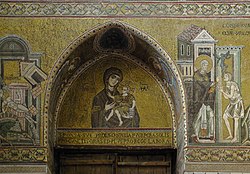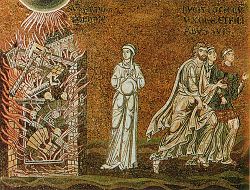Top Qs
Timeline
Chat
Perspective
Monreale Cathedral mosaics
Mosaics at Monreale Cathedral in Sicily From Wikipedia, the free encyclopedia
Remove ads
The Monreale Cathedral Mosaics are the main internal feature of Monreale Cathedral in the city of Palermo, Sicily, Italy; the mosaics cover 6,500 m2. It was constructed at the orders of King William II and later was beatified to the Assumption of the Virgin. The Monreale Cathedral is located in the city of Palermo, Sicily, Italy. The mosaics are made up of glass tesserae in the Byzantine style. The Byzantine style was spread to areas of Italy due to trade and conquest. Recently, there has been an increase in research conducted on the Monreale Cathedral mosaics, to attempt to reveal methods by which they produced the mosaics after the 12th century.

Remove ads
History
The Monreale Cathedral was ordered to be constructed by King William II (1167 -1189). The cathedral was then erected in a royal park on the site of an earlier Greek church. However, work on the structure as well as its decoration was, for the most part, completed following the death of the king in 1189. The cathedral was then later consecrated to the Assumption of the Virgin.[1]
Description
Summarize
Perspective
The mosaics are made of glass tesserae and were executed in Byzantine style between the late 12th and the mid-13th centuries by local masters.[2] With the exception of a high dado, made of marble slabs with bands of mosaic between them, the whole interior surface of the walls, including soffits and jambs of all the arches, is covered with minute mosaic-pictures in bright colors on a gold ground. The mosaic pictures, depicting stories from both the Old and New Testament, are arranged in tiers, divided by horizontal and vertical bands. In parts of the choir there are five of these tiers of subjects or single figures one above another.
The interior of the Monreale Cathedral is home to a plethora of religious mosaics. The interior is extremely vast and has a multitude of opulent decoration. Amongst the mosaics are also antique columns, marble paneling along the lower sections of the walls, and an elaborate floor in the sanctuary. The mosaics, which covering the upper sections of the sanctuary and nave walls, span approximately 6,500 square meters, as mentioned prior. This expansive array of mosaics makes the Monreale Cathedral home to Italy's most extensive mosaic decoration, which surpasses that of Venice's San Marco.
Remove ads
The Byzantine style
Summarize
Perspective
The Byzantine style describes art that was produced by the Byzantine Empire during the Middle Ages. Byzantine art manifested in a variety of mediums, including painting, architecture, mosaics, metalwork, and ivory reliefs; however it is widely recognized for its use of opulent gold icons that continue to decorate many churches to this day.[3]
The spread of Byzantine art
Byzantium constituted the eastern branch of the Roman Empire, which at one point, encompassed extensive territories across the Mediterranean, including present-day Turkey, Southern Spain, and Italy.[3] Orthodox Christianity was established as the centralized form of religion, thereby infusing art that was created with predominantly devotional themes.
During the reign of Emperor Justinian, spanning from 527 to 565, Constantinople was established as the epicenter of the empire. Justinian also then led the creation of the Hagia Sophia, while creating workshops dedicated to a plethora of art forms, including icon painting, ivory carving, etc.[3] The Emperor pushed the dissemination of ideas and iconographic styles to Ravenna in Italy wherein the San Vitale church later came to epitomize the essence of the Byzantine era.
Byzantine style art was spread to areas of Italy and Sicily via trade as well as conquest.[4] The Byzantine style and forms of art then existed in a modified form throughout the 12th century, later being influential forces on forming Italian Renaissance art. Byzantine forms of art also reached eastern European areas, Russia in particular, through the growth of the Eastern Orthodox Church. Upon reaching Russia, Byzantine art styles remained prevalent with regional modifications, throughout the 17th century.[4]
The mosaics of the Cathedral of Monreale were influenced by the spread of Byzantine art throughout Southern Italy and Sicily. Many Byzantine artists remaining in Italy after the Islamic conquest of Sicily in 965, took part in decorating the interiors of many structures, including the many mosaics that reflect the Byzantine style of the artists.[5] Later Sicilian kings of the Norman dynasty went on to build large cathedrals, the Cathedral of Monreale included, in the same Byzantine style that had been largely influencing the region during that time.[5]
Characteristics
The Byzantine style also rejects more realistic forms found typical within classical Roman works, and instead portraying subjects in a flattened form. During the peak era of Byzantine style, it was also characterized by elongated figures, angular shapes and faces, defined edges, flattened hues, and is embellished with gold accents.[3] This is evident in the Monreale Cathedral Mosaics with the image of Christ the Pantokrater, where he has a sharp and more pointed face and the work is filled with gold accents and surrounding background. The surrounding mosaics of other religious figures are similarly styled with Byzantine characteristics including the elongated figures and gold accents.
Icons
Icons, especially depicting Christ, the Virgin Mary, among other highly revered religious figures, were commonly favored in the Byzantine era. In the Byzantine style, holy figures were depicted in the front and stared directly at the viewer, which was believed to allow for communication and connection with the divine figure being depicted, giving the work a more intense devotional aspect. [3]This choice in icons is reflected in the choice of depicting Christ Pantokrater in the dome of the cathedral in Monreale.
Remove ads
Subjects
Summarize
Perspective
The Monreale Cathedral Mosaics depict a number of well-known and renowned religious figures and iconography. There are also depictions of stories from the Bible represented within the many mosaic decorations of the Monreale Cathedral, including the journey of Noah's Ark along with the labour of Adam and Eve.[1]
As shown in the first figure of the East apse, there is a prominent hand-figure of Christ Pantocrator, which exhibits a superior style when compared to other depicted figures.[1] Christ is the largest figure compared to the other smallers figures below and surrounding the East Apse. Below, the next focal point is an image of an enthroned Madonna and Child, whom are flanked by archangels and apostles.
There are also enthroned images of the apostles, Saint Peter and Saint Paul, that are displayed on the apse culottes, where scenes from their lives decorate the nearby walls.[1]
A comprehensive depiction of the life of Christ is shown across three levels upon the walls of the crossing as well as the Cathedral’s transepts.[1] This mosaic narrative extends into the nave, where there are forty two scenes taken from the Genesis which are portrayed across two separate levels. Additionally, the side aisles feature mosaics that illustrate the miracles of Christ.
Inscriptions on each picture explain the subject or saint represented; these are in Latin, except for some few which are in Greek. The subjects in the nave begin with scenes from the Book of Genesis, illustrating the Old Testament types of Christ and His scheme of redemption, with figures of those who prophesied and prepared for His coming.[1] Around the lower tier and the choir are subjects from the New Testament, chiefly representing Christ's miracles and suffering, with apostles, evangelists and other saints. The design, execution and choice of subjects all appear to be of Byzantine origin, the subjects being selected from the Menologion of Basil II drawn up by the emperor Basil II in the 10th century.
Remove ads
New chemical and mineralogical data
There is a lack of knowledge in regards to the raw materials as well as the type of technology utilized during the production of mosaics created after the twelfth century. Due to this lapse in knowledge and available information, an archaeometric investigation was executed, which worked to examine the materials that were used for the mosaic decoration of the South aisle wall of the Monreale Cathedral.[6]
During this investigation, they examined pieces of fallen colored and gilded glass tesserae by combining the molecular technique of Raman spectroscopy, as well as an elemental technique which utilized a portable X-ray Fluorescence.
Remove ads
By location
Summarize
Perspective
Source:[7]
Inner facade

South side

Saints
North wall

Saints
East Apses
Remove ads
Apsidal arch
 |
 |
| King William II Crowned by Christ | King William II Offering the Church to the Virgin Mary |
Old Testament
Creation cycle
Earthly Paradise cycle
Noah's Flood cycle
Abram cycle
Remove ads
New Testament
Life of Christ
Christ's Miracles (south side)
Christ's Miracles (north side)
Nativity (south side)
 |
| Christ Tempted |
Passion (south side)
 |
 |
 |
 |
| Madonna and Child | Christ Washing the Disciples' Feet | Arrest of Christ | Last Supper |
Saint Peter cycle
Saint Paul cycle
Remove ads
References
Bibliography
Wikiwand - on
Seamless Wikipedia browsing. On steroids.
Remove ads



































